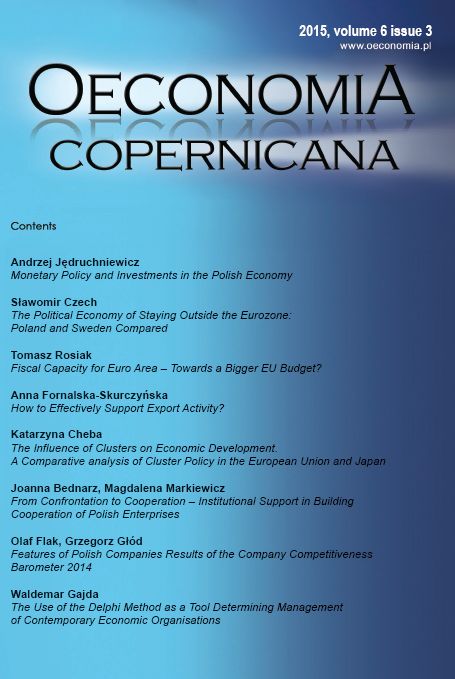Monetary policy and investments in the Polish economy
DOI:
https://doi.org/10.12775/OeC.2015.018Keywords:
monetary policy, interest rates, investment growth, investment structureAbstract
Investments are an important source of development of enterprises and the economy. They depend on many factors. According to most of the major economic schools, an important factor influencing the level and dynamics of investment inputs is monetary policy. The main objective of the study is to investigate the influence of monetary policy of Polish National Bank on the dynamics and structure of investments in Poland. Due to the realistic theory of capital, investment changes were assessed primarily from the point of view of the Austrian school. Research methods that were used in this study include deduction and statistical analysis. In the years 2006-2013, the Polish economy has performed moderately linear relationship between the reference interest rate and the dynamics of investments. Changes in monetary policy led to a disproportionate growth of production of various goods both in periods of better and bad economic situation. Volatility of capital inputs was substantially higher than the production of consumer goods. Also, investments in industries at the early stages of the production structure changed more dynamically than those in sectors that are closest to the consumer. The obtained results confirm the theory of the Austrian School.
Downloads
References
Bernanke B. S., Gertler M., Gilchrist S. (1999), The Financial Accelerator in a Quantitative Business Cycle Framework. In J. B. Taylor, M. Woodford (Ed.), Handbook of Macroeconomics. Amsterdam: Elsevier.
Biuletyn Statystyczny (2014), Warszawa: GUS.
Blaug, M. (2002). Ugly Currents in Modern Economics. In U. Mäki (Ed.), Fact and Fiction in Economics, Cambridge: Cambridge University Press. http://dx.doi.org/10.1017/CBO9780511493317.003.
Butos, W. N. (2006). Money, Prices, and Capital: An Austrian Approach to Macroeconomics. Quarterly Journal of Austrian Economics, 4(9). http://dx.doi.org/10.1007%2Fs12113-006-1020-2.
Clarida, R., Gali, J., Gertler, M. (1999). The Science of Monetary Policy: A New Keynesian Perspective. Journal of Economic Literature, 2(37). http://dx.doi.org/10.1257/jel.37.4.1661.
Doing Business (2007-2014). Retrieved form http://www.doingbusiness.org/ (23.11.2014).
Encyklopedia biznesu (1995), t. 1. Warszawa: Fundacja Innowacja.
Friedman, M., Schwartz, A. (1963). A monetary history of the United States 1867-1960. Princeton: Princeton University Press.
Hayek, F. A. (1967). Prices and Production. New York: Augustus M. Kelly.
Index of Economic Freedom (2014). Retrieved from http://www.heritage.org/in dex/visua lize (23.11.2014).
Jurek, W. (2013). O matematycznym podejściu do problemów ekonomicznych, Studia Oeconomica Posnaniensia, 1(250).
Kapuściński, M., Łyziak, T., Przystupa, J., Stanisławska, E., Sznajderska, A., Wróbel, E. (2014). Monetary policy transmission mechanism in Poland. What do we know in 2013?, Working Paper No 180. Warsaw: NBP.
Kokoszczyński, R. (2004). Współczesna polityka pieniężna w Polsce. Warszawa: PWE.
Leszek, P. (2013). Matematyka: język fizyki w dobrej służbie ekonomii? Studia Ekonomiczne. Economic Studies, 1(LXXVI).
Lucas, R. E. (1972). Expectations and the Neutrality of Money. Journal of Economic Theory, 4. http://dx.doi.org/10.1016/0022-0531(72)90142-1.
Masior, M. (2014). Komentarz do wyników rankingu Doing Business 2015 dla Polski. Analiza FOR nr 13. Retrieved from http://www.for.org.pl/pl/a/ 3276,Analiza-FOR-132014-Komentarz-do-wynikow-Doing-Business-2015-dla-Polski (23.11.2014).
Mayer, T. (1996). Prawda kontra precyzja w ekonomii. Warszawa: Wydawnictwo Naukowe PWN.
Mises, L. von (2007). Ludzkie działanie. Traktat o ekonomii. Warszawa: Instytut Ludwika von Misesa.
Mojon, B., Smets, F., Vermeulen, P. (2002). Investment and monetary policy in the euro area. Journal of Banking & Finance, 11(26). http://dx.doi.org/10.1016/S03 78-4266(02)00202-9.
O?Driscoll, G. P., Rizzo M. J. (1996). The Economics of Time and Ignorance. London-New York: Routledge.
Podstawowe stopy procentowe NBP w latach 1998 ? 2013 (2014). Source http://www.nbp.pl/home.aspx?f=/dzienne/stopy_archiwum.htm (22.11.2014).
Rocznik Statystyczny Przemysłu (2013). Warszawa: GUS.
Rothbard, M. N. (2008). Ekonomia wolnego rynku, t. 3. Warszawa: Fijorr Publishing.
Skousen, M. (2011). Struktura produkcji. Giełda, kapitał, konsumpcja. Warszawa: Fijorr Publishing.
Sobczyk, M. (2006). Statystyka. Aspekty praktyczne i teoretyczne. Lublin: Wydawnictwo Uniwersytet Marii Curie-Skłodowskiej.
Snowdon, B., Vane, H., Wynarczyk, P. (1998). Współczesne nurty teorii makroekonomii. Warszawa: Wydawnictwo Naukowe PWN.
Strategia polityki pieniężnej po 2003 r. (2003). Warszawa: NBP.
Svensson, L. E. O. (1999). Inflation targeting as a monetary policy rule. Journal of Monetary Economics, 3(43). http://dx.doi.org/10.1016/S0304-3932(99)00007-0.
Środki trwałe w gospodarce narodowej w 2012 roku (2013). Warszawa: GUS.
Vermeulen, P. (2002). Business fixed investment: evidence of a financial accelerator in Europe. Oxford Bulletin of Economics and Statistics, 3(64). http://dx.doi.org/10.1111/1468-0084.00020.
Warżała, R. (2014). Morfologia cykli koniunkturalnych w Polsce. Ekonomista, 1.
White, L. H. (2011). The Methodology of the Austrian School Economists. Auburn: The Ludwig von Mises Institute, Auburn University.
Wiśniewski, J. B. (2012). Metodologia austriackiej szkoły ekonomii: obecny stan wiedzy. Retrieved form http://mises.pl (12.11.2014).
Wojtyna, A. (2000). Ewolucja keynesizmu a główny nurt ekonomii. Warszawa: Wydawnictwo Naukowe PWN.
Wskaźniki makroekonomiczne (2014). Source http://stat.gov.pl/wskazniki-makroekonomiczne/ (23.11.2014).
Ustawa z 29 sierpnia 1997 r. o Narodowym Banku Polskim, Dz. U. 1997, nr 140.






